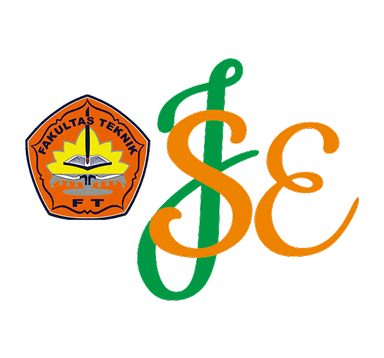Efektivitas Konsorsium Mikroalga Chlorella sp. dan Mikroba Indigenous Dalam Menurunkan BOD, COD, dan TN Air Limbah Industri Kecap Menggunakan MBBR
Keywords:
soy sauce wastewater, Chlorella sp., indigenous, consortium, MBBRAbstract
The treatment of soy sauce effluent poses a significant environmental challenge due to its high levels of contaminants. Several studies have shown that the use of Chlorella sp. microalgae can contribute to the degradation of BOD, COD and TN using a moving bed biofilm reactor (MBBR). Therefore, this study aims to determine the effectiveness of a consortium of Chlorella sp. microalgae and indigenous microbes in treating soy sauce wastewater using an MBBR with an anoxic-oxic process. This research uses a continuous system with variations in the volume of alkaline media (20%, 40%, 60%) and sampling times (14, 26, 38 hours). The best variation for the reduction of organic content in soy sauce wastewater using the Chlorella sp. microalgae consortium achieved a BOD reduction of 71.54%, COD reduction of 74% and TN reduction of 71.89%, all at a sampling time of 38 hours. Meanwhile, the organic reduction using indigenous microbes showed a BOD reduction of 86.76%, COD reduction of 88.24% and TN reduction of 82.76%, all at a sampling time of 38 hours.
References
[1] F. A. Setyawan, D. R. Widiana, and A. V. Sophia, "Analisis akar penyebab kegagalan instalasi pengolahan air limbah industri kecap menggunakan metode root cause analysis," Conference Proceeding on Waste Treatment Technology, vol. 5, no. 1, pp. 186–190, 2022
[2] A. Y. G. Dirgantoro, "Perbaikan kualitas limbah cair industri kecap dan saos PT. Lombok Gandaria dengan variasi bakteri indigenus," Program Studi Biologi, Universitas Atma Jaya Yogyakarta, Yogyakarta, 2017.
[3] N. I. Said and T. I. Santoso, "Penghilangan polutan organik dan padatan tersuspensi di dalam air limbah domestik dengan proses moving bed biofilm reactor (MBBR)," Jurnal Air Indonesia, vol. 8, no. 1, pp. 33–46, 2015.
[4] M. Chairani, S. Elystia, and S. R. Muria, "Penyisihan nitrogen total dalam limbah cair hotel dengan sistem moving bed biofilm reactor menggunakan Chlorella sp.," JST (Jurnal Sains Dan Teknologi), vol. 10, no. 1, pp. 16–27, 2021.
[5] B. C. Ningtias, S. S. Moersidik, C. R. Priadi, and N. I. Said, "Pengolahan air limbah domestik dengan anoksik-aerobik moving bed biofilm reactor (studi kasus: Penyisihan amonia dan karbon dalam air limbah domestik)," Jurnal Air Indonesia, vol. 8, no. 2, pp. 177–188, 2018.
[6] A. Fallahi, F. Rezvani, H. Asgharnejad, E. Khorshidi, N. Hajinajaf, and B. Higgins, "Interactions of microalgae-bacteria consortia for nutrient removal from wastewater: A review," Chemosphere, vol. 272, no. 129878, 2021.
[7] D. Kang and K. Kim, "Real wastewater treatment using a moving bed and wastewater-borne algal–bacterial consortia with a short hydraulic retention time," Processes, vol. 9, no. 1, pp. 1–15, 2021.
[8] A. Masta, S. Elystia, and S. R. Muria, "Pengaruh variasi debit udara terhadap efisiensi penyisihan COD dalam limbah cair hotel pada sistem moving bed biofilm reactor (MBBR) menggunakan Chlorella sp.," JOM FTEKNIK, vol. 7, 2020.
[9] N. Hendrasarie and I. I. Yadaturrahmah, "Pengaruh penambahan impeller pada fase aerobik terhadap efisiensi kinerja sequencing batch reactor pada limbah cair industri tahu," Jurnal Envirotek, vol. 13, no. 1, pp. 7–13, 2021.
[10] N. Hendrasarie, "Buah Siwalan sebagai adsorben dan media lekat biofilm pada pengolahan limbah domestik menggunakan sequencing batch reactor," Jurnal Envirous Teknik Lingkungan Universitas Pembangunan Nasional “Veteran” Jawa Timur, vol. 1, pp. 98–105, 2022.
[11] N. I. Said, Teknologi Pengolahan Air Limbah, Teori dan Aplikasi. Erlangga, 2017.
[12] Metcalf and Eddy, Wastewater Engineering: Treatment and Reuse, 4th ed., McGraw-Hill Companies, Inc., 2003.
[13] N. Hendrasarie and M. N. Trilta, "Removal of nitrogen-phosphorus in food wastewater treatment by the Anaerobic Baffled Reactor (ABR) and Rotating Biological Contactor (RBC)," IOP Conference Series: Earth and Environmental Science, vol. 245, no. 1, 2019.
[14] E. Wahyu and N. Hendrasarie, "Penurunan kandungan zat pencemar organik pada air limbah rumah potong ayam dengan biofilter aerob menggunakan media kulit kerang," Jurnal Envirous Teknik Lingkungan, vol. 3, no. 1, pp. 19–25, 2022.
[15] S. Elystia, V. M. Rizani, and S. R. Muria, "Penyisihan polutan pada palm oil mill effluent (POME) menggunakan konsorsium mikroalga-bakteri dengan sistem high rate algae reactor (HRAR)," Jurnal Sains Teknologi & Lingkungan, vol. 7, no. 1, pp. 146–159, 2021.
[16] S. R. Muria, F. M. Shiddiq, I. Damayanti, and I. Purnama, "Kultivasi mikroalga Chlorella sp. secara fed-batch menggunakan limbah cair tahu untuk produksi lipid," JBChEES, vol. 4, no. 1, pp. 37–56, 2023.
[17] N. Hendrasarie and F. I. Zarfandi, "Integrated anoxic-oxic sequencing batch reactor combined with coconut fiber waste as biofilm and adsorbent media," Journal of Ecological Engineering, vol. 24, no. 11, pp. 176–189, 2023.
[18] N. Hendrasarie and B. A. Santosa, "Pengolahan limbah cair rumah potong hewan menggunakan rotating biological contactor modifikasi sludge zone," Journal of Research and Technology, vol. 5, no. 2, pp. 168–177, 2019.
Downloads
Published
Issue
Section
License
Copyright (c) 2024 Zuhria Oktaviani, Novirina Hendrasarie (Author)

This work is licensed under a Creative Commons Attribution 4.0 International License.












